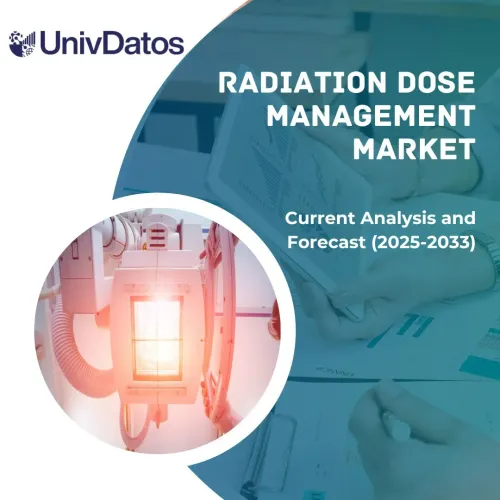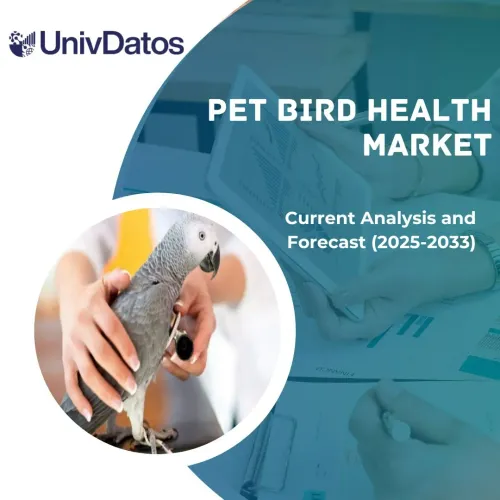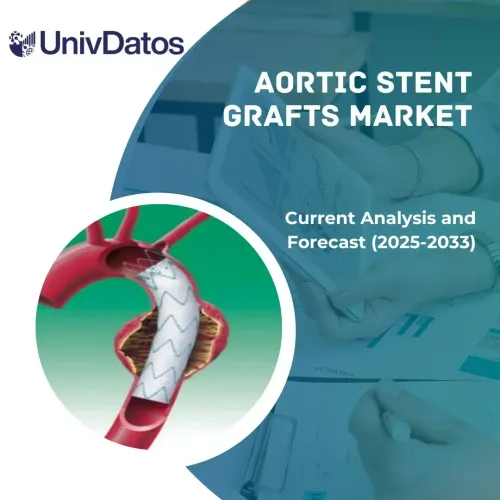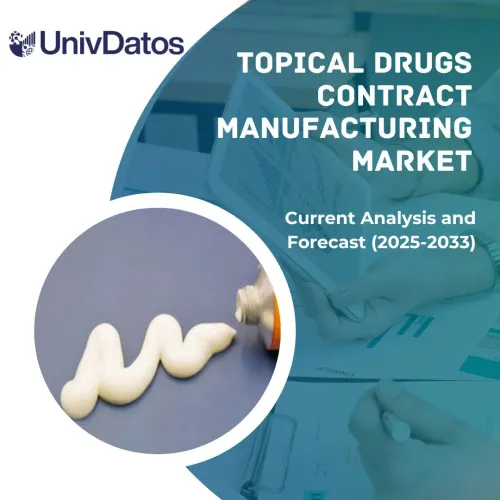- Home
- About Us
- Industry
- Services
- Reading
- Contact Us
Industrial Alcohol Market: Current Analysis and Forecast (2022-2028)
Emphasis on Type (Ethyl Alcohol, Methyl Alcohol, Isopropyl, Isobutyl Alcohol, and Others); Source (Grains, Sugar & Molasses, Corn, Fossil Fuels, and Others); Application (Personal Care, Chemical Intermediates, Food Industry, Pharmaceutical, Fuels, and Others); and Region/Country
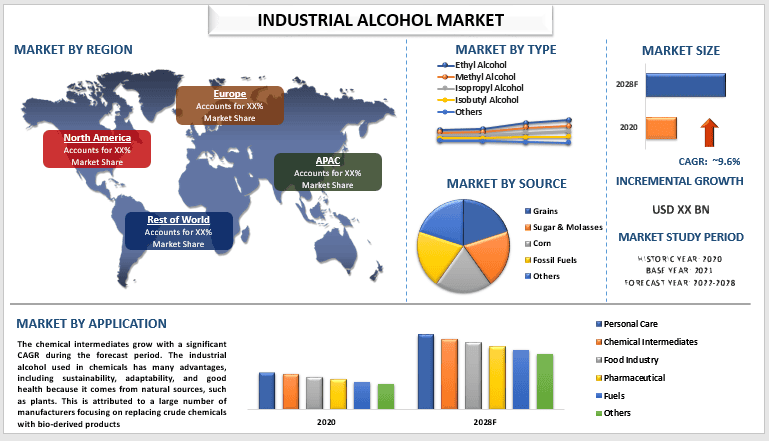
Global Industrial Alcohol Market is expected to grow at a significant rate of around 9.6% during the forecast period 2022-2028. Industrial alcohol means alcohol that is produced for 47-68 industrial purposes only and is not fit for human consumption. The fermentation of sugars extracted from wheat, corn, sugar beets, sugar cane, and molasses results in the production of biofuels. Therefore, the rising consumption and demand for ethanol as biofuel drive market growth. In 2021, for the second time since tracking began, the U.S. exported more oil than was imported. The average U.S. petroleum consumption was 19.8 million barrels per day. In 2021, there were 197 ethanol refineries and 75 biodiesel production plants in the U.S. as per the U.S. Energy Information Administration.
The market is also anticipated to grow as a result of proactive government measures, rising methanol consumption in the chemical industry with spiraling growth in production facilities. Major company alliances to reduce greenhouse gas emissions and minimize the dependence of the energy industry on imported fossil fuels are expected to boost market growth. For instance, in July 2020, Green Plains expanded its facility at its subsidiary, Green Plain Wood River LLC, for the production of FCC-grade and USP-grade alcohol meeting FDA specifications to reduce greenhouse gas emissions.
Cargill Incorporated; MGP Ingredients, Inc., Green Plains Inc, Cristalco, GREENFIELD GLOBAL INC., Flint Hills Resources, Merck KGaA, The Andersons Inc, BASF SE, Raízen are some of the key players in the market. Several M&As along with partnerships have been undertaken by these players to facilitate customers with hi-tech and innovative products/technologies.
Insights Presented in the Report
“Amongst type, Ethyl Alcohol held a significant share of the market in 2020”
Based on type, the market is segmented into ethyl alcohol, methyl alcohol, isopropyl, isobutyl alcohol, and others. Ethyl alcohol held a significant share of the market in 2020. Ethyl alcohol reduces vehicle emissions, improves air quality, increases energy independence, lower consumer fuel prices, and provide value-added markets for American farmers. Thus, the above-mentioned factors drive market growth.
“Amongst application, the chemical intermediates grow with a significant CAGR during the forecast period”
Based on the application, the industrial alcohol market has been classified into personal care, chemical intermediates, food industry, pharmaceutical, fuels, and others. The chemical intermediates grow with a significant CAGR during the forecast period. The industrial alcohol used in chemicals has many advantages, including sustainability, adaptability, and good health because it comes from natural sources, such as plants. This is attributed to a large number of manufacturers focusing on replacing crude chemicals with bio-derived products.
“North America to hold a significant share in the market”
In 2020, North America held a significant share of the global industrial alcohol market. The industry is expanding rapidly due to the growing use of ethanol as a fuel for transportation applications. The Environmental Protection Agency (EPA) has a number of programs in place to assist environmentally friendly and sustainable goods made using renewable energy sources. The demand for ethanol fuel is significantly increasing as more people buy cars, which lowers overall costs. The Food Safety Modernization Act’s requirements must be followed by ethanol manufacturing facilities in order to comply with U.S. Food & Drug Administration regulations (FSMA). These preventive measures assure customers all around the world that American ethanol co-products with safe feed components are produced. The market for industrial alcohol in North America is predicted to increase significantly as a result of these causes.
Reasons to buy this report:
- The study includes market sizing and forecasting analysis validated by authenticated key industry experts.
- The report presents a quick review of overall industry performance at one glance.
- The report covers an in-depth analysis of prominent industry peers with a primary focus on key business financials, product portfolio, expansion strategies, and recent developments.
- Detailed examination of drivers, restraints, key trends, and opportunities prevailing in the industry.
- The study comprehensively covers the market across different segments.
- Deep dive regional level analysis of the industry.
Customization Options:
The global industrial alcohol market can further be customized as per the requirement or any other market segment. Besides this, UMI understands that you may have your own business needs, hence feel free to connect with us to get a report that completely suits your requirements.
Table of Content
Research Methodology for the Industrial Alcohol Market Analysis (2022-2028)
Analyzing the historical market, estimating the current market, and forecasting the future market of the global industrial alcohol market were the three major steps undertaken to create and analyze the adoption of industrial alcohols in major regions globally. Exhaustive secondary research was conducted to collect the historical market numbers and estimate the current market size. Secondly, to validate these insights, numerous findings and assumptions were taken into consideration. Moreover, exhaustive primary interviews were also conducted, with industry experts across the value chain of the global industrial alcohol market. Post assumption and validation of market numbers through primary interviews, we employed a top-down/bottom-up approach to forecasting the complete market size. Thereafter, market breakdown and data triangulation methods were adopted to estimate and analyze the market size of segments and sub-segments of the industry pertains to. Detailed methodology is explained below:
Analysis of Historical Market Size
Step 1: In-Depth Study of Secondary Sources:
Detail secondary study was conducted to obtain the historical market size of the industrial alcohol market through company internal sources such as annual reports & financial statements, performance presentations, press releases, etc., and external sources including journals, news & articles, government publications, competitor publications, sector reports, third-party database, and other credible publications.
Step 2: Market Segmentation:
After obtaining the historical market size of the industrial alcohol market, we conducted a detailed secondary analysis to gather historical market insights and share for different segments & sub-segments for major regions. Major segments are included in the report as type, source, and application. Further country-level analyses were conducted to evaluate the overall adoption of testing models in that region.
Step 3: Factor Analysis:
After acquiring the historical market size of different segments and sub-segments, we conducted a detailed factor analysis to estimate the current market size of the industrial alcohol market. Further, we conducted factor analysis using dependent and independent variables such as various type, source, and applications of industrial alcohols. A thorough analysis was conducted for demand and supply-side scenarios considering top partnerships, mergers and acquisitions, business expansion, and product launches in the industrial alcohol market sector across the globe.
Current Market Size Estimate & Forecast
Current Market Sizing: Based on actionable insights from the above 3 steps, we arrived at the current market size, key players in the global industrial alcohol market, and market shares of the segments. All the required percentage shares split, and market breakdowns were determined using the above-mentioned secondary approach and were verified through primary interviews.
Estimation & Forecasting: For market estimation and forecast, weights were assigned to different factors including drivers & trends, restraints, and opportunities available for the stakeholders. After analyzing these factors, relevant forecasting techniques i.e., the top-down/bottom-up approach were applied to arrive at the market forecast for 2028 for different segments and sub-segments across the major markets globally. The research methodology adopted to estimate the market size encompasses:
- The industry’s market size, in terms of revenue (USD) and the adoption rate of the industrial alcohol market across the major markets domestically
- All percentage shares, splits, and breakdowns of market segments and sub-segments
- Key players in the global industrial alcohol market in terms of products offered. Also, the growth strategies adopted by these players to compete in the fast-growing market
Market Size and Share Validation
Primary Research: In-depth interviews were conducted with the Key Opinion Leaders (KOLs) including Top Level Executives (CXO/VPs, Sales Head, Marketing Head, Operational Head, Regional Head, Country Head, etc.) across major regions. Primary research findings were then summarized, and statistical analysis was performed to prove the stated hypothesis. Inputs from primary research were consolidated with secondary findings, hence turning information into actionable insights.
Split of Primary Participants in Different Regions

Market Engineering
The data triangulation technique was employed to complete the overall market estimation and to arrive at precise statistical numbers for each segment and sub-segment of the global industrial alcohol market. Data was split into several segments & sub-segments post studying various parameters and trends in the areas of type, source, and application in the global industrial alcohol market.
The main objective of the Global Industrial Alcohol Market Study
The current & future market trends of the global industrial alcohol market were pinpointed in the study. Investors can gain strategic insights to base their discretion for investments on the qualitative and quantitative analysis performed in the study. Current and future market trends determined the overall attractiveness of the market at a regional level, providing a platform for the industrial participant to exploit the untapped market to benefit from a first-mover advantage. Other quantitative goals of the studies include:
- Analyze the current and forecast market size of the industrial alcohol market in terms of value (USD). Also, analyze the current and forecast market size of different segments and sub-segments
- Segments in the study include areas of type, source, and application.
- Define and analysis of the regulatory framework for the industrial alcohol
- Analyze the value chain involved with the presence of various intermediaries, along with analyzing customer and competitor behaviors of the industry.
- Analyze the current and forecast market size of the industrial alcohol market for the major region.
- Major countries of regions studied in the report include Asia Pacific, Europe, North America, and the Rest of the World.
- Company profiles of the industrial alcohol market and the growth strategies adopted by the market players to sustain in the fast-growing market
- Deep dive regional level analysis of the industry
Related Reports
Customers who bought this item also bought

